The search for the best overdrive pedal is something that guitarists never stop doing. There are so many options out there, and it’s a very useful tool for a very wide range of players.
Just like having a good guitar and a good amp, a decent overdrive pedal is something that many guitarists can’t live without.
For some, the best overdrive pedal might be the one that pushes a tube amp into a more natural overdrive, while retaining all the tonal characteristics of the guitar.
However, those with solid-state amps might prefer to add a little more ‘something’ to their existing sound. You can even get an overdrive pedal that gives you the breakup sound of some classic tube amps.
Overdrive can be a nice effect to have on all the time, or it can be used to boost a clean sound for solos, or it can be paired with other pedals. The possibilities seem endless.
This list rounds up the best overdrive pedals available across a variety of styles, tones, and price points, so no matter what kind of drive you’re looking for, you’ll find one that’s right for you.
Top 10+ Best Overdrive Pedals in 2025
1. Origin Effects RevivalDrive

The RevivalDRIVE Compact is an amp-in-a-box style overdrive pedal that delivers tube amp tones at your feet.
With the RevivalDrive, Origin Effects aimed to provide the sound and circuit behavior of classic amps in a fully variable and controllable form.
The resulting dual-channel pedal features a bypass footswitch and a second switch to switch between channels.
Each has the same set of controls, but one channel is based on a valve rectifier while the other uses a solid-state (silicon) rectifier for a different response associated with each.
The two channels are distinct enough, with the silicon channel offering a tighter, more aggressive feel than the fluffy sag of the valve channel.
With the ability to emulate a variety of amps, especially Marshall and Fender models, or to provide overdrive perfectly tailored to expand clean amp tones, it delivers the right cranked vintage amp sound at real stage and home levels, no matter what amp you use.
2. Vemuram Shanks ODS-1
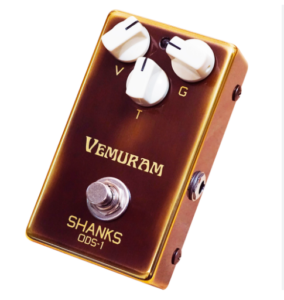
Vemuram started appearing on professional pedalboards a few years ago, and it immediately caught the attention of pedal enthusiasts.
Many were probably quite shocked when they found out the price. First of all, the biggest reason to avoid the Vemuram Shanks ODS-1 is the price.
At over $400, it’s a lot of money for a single-function overdrive, but the price tag is huge, and so is the tone.
Using a circuit derived from the Nobels ODR-1 and designed in collaboration with the namesake John Shanks, it adds a nice bit of gain to the sound without any noticeable EQ coloration, and has a nice natural compression function that provides plenty of saturation with just the right amount of ‘squash’.
It’s hard to quantify why the Shanks sounds so good, but it just sounds expensive.
The tone is much more complex and rich due to the Shanks’ signal path.
The response is like a vintage tube amp, and you can really feel the dynamic engagement, and the addition of bass and saturation trim pots on the top of the pedal adds a level of flexibility that is hard to come by in a pedal.
If you’re on a budget, there are plenty of other pedals that use this common circuit type, but if you can stretch your budget, the Shanks’ tone is noticeably improved over its competitors, and the compliments from those jealous of their shiny Vemuram pedals are a nice ego booster.
3. JHS Morning Glory V4
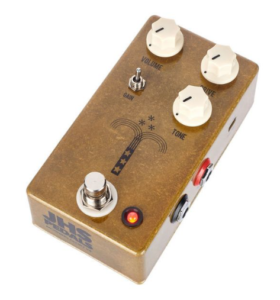
The JHS Morning Glory is a re-creation and evolution of the infamous Bluesbreaker tone.
The original Blues Breaker pedal was released by Marshall and was designed to capture the sound of the JTM45 combo used by Clapton on the Beano album (with John Mayall & The Bluesbreakers) in the 1960s.
After several iterations, Marshall eventually discontinued the original pedal, and the original pedal sold for a fortune on the second-hand market.
The Morning Glory is based on the original pedal with extra headroom, a high/low gain toggle, and a bright cut switch. Some people might think of this as an amp in a box, which makes sense since it’s based on an amp.
One of the coolest features is the jack socket for the separately purchased JHS Red Remote.
This is a great option if you want to toggle the high/low gain modes with a footswitch. This is also, coincidentally, one of JHS’s best-selling pedals of all time.
4. JHS Double Barrel V4
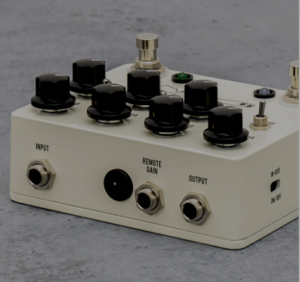
Despite the fundamentally simple concept of overdrive, there are endless variations possible from a single pedal.
The JHS Double Barrel proves this by featuring two of the company’s famous individual pedals, giving users a wide range of tone-shaping potential to choose from.
The Morning Glory V4 side offers simple boosting, adding transparent push and increased dynamics without coloring the tone.
The Moonshine V2 side has tube-like saturation that responds well to picking and other controls.
5. Wampler Tumnus
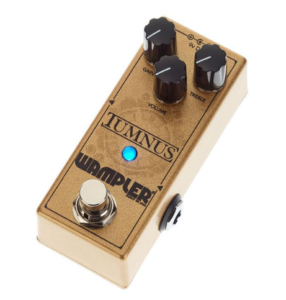
The original Klon Centaur is right in the middle of the Venn diagram overlap between ‘rare’ and ‘expensive’, but fortunately there are a number of high-quality clones on the market, and the Tumnus is one of the better units in our opinion.
Not only is it a faithful reproduction of the most unobtainable overdrive in the industry, but it comes in a small form factor enclosure the size of a 1590A, so it doesn’t take up much pedalboard space.
In terms of sound, the Klon is often described as ‘transparent’, but we’ve always found it to be quite colorful, with a tough drive tone at low gain settings and a crisp, dry tone when boosted.
This is also the case with the Tumnus.
It’s not transparent, but it can be used as a slightly flashy boost in front of a tube amp when the gain is turned down and the volume is turned up.
While it would be crazy to buy an original unit for this purpose, it’s not blasphemous to saturate a tube amp with a cheap Tumnus.
6. Benson Preamp Pedal
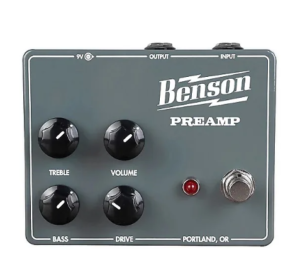
Benson amps are probably the most popular boutique brand right now. Especially the Chimera model.
Fittingly, I’m writing this while watching the Chimera flagship being unveiled at the Star Wars Ahsoka show… but anyway, this pedal is essentially the gain stage of the Chimera amp in a pedal.
As such, it’s very amp-like and flexible compared to most overdrive topologies. It’s not a tube screamer or clone. Instead, it can do everything from a light boost to a sizzling fuzz.
If you want a distinct tonal drive section that can cover a wide range, I’d prefer this pedal over the more restrained genres.
7. MXR Duke of Tone
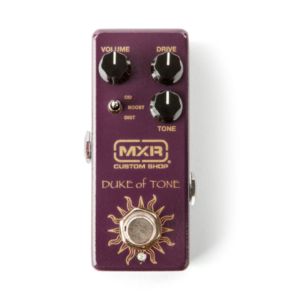
The MXR Duke of Tone is a popular remake of the legendary Analog Man Prince of Tone, designed in collaboration with Analog Man.
If you want the authentic Prince of Tone, you’ll have to stand in line and get your name on Analog Man’s 5-year waiting list.
Luckily, the Duke of Tone is readily available and sounds exactly the same. That’s because the circuitry is identical, save for a few internal dip switches.
The Duke of Tone is essentially a ‘bluesbreaker’ style design, adding warmth and a really powerful backbone to the sound when in operation.
With three modes – push clean (‘boost’ mode), crunch (‘OD’ mode) and dirty (‘distortion’ mode), the Duke of Tone is a pedal for those looking for versatility.
It’s not as sharp and sharp as some overdrives, and the EQ curve of the sound is generally flat, but it’s clear in all modes, cuts through the mix, and has a great ability to respond dynamically to your playing.
A really nice feature of the Duke of Tone is that it can be run on either 9V or 18V, with the 18V mode providing extra headroom, which is especially noticeable in ‘boost’ mode, adding to the pedal’s versatility.
Anyone looking for something small but with a wealth of tonal options should seriously consider the Duke of Tone.
8. JHS Morning Glory
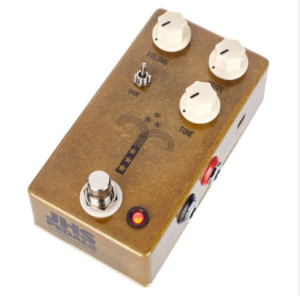
The Morning Glory was one of the pedals that put JHS on the map and forever changed the concept of boutique manufacturers, and for good reason.
Some may see it as just another Bluesbreaker-style transparent overdrive, but the Morning Glory is fat and enjoyable sounding, with a solid low end and crisp highs. Its tonal beauty has made the boutique mainstream.
As a ‘transparent’ drive, it really amplifies the character of your guitar and amp, so for those with less than satisfactory setups, the Morning Glory may leave you even more dissatisfied.
That said, if you like your gear as is, the Morning Glory is the cherry on the cake, opening up a new dimension of sweet yet subtle harmonic content that wasn’t there before.
The Morning Glory is effortlessly simple, which is one of its appealing features, but if you want more tonal options, JHS’s ‘Double Barrel’ is two overdrives in one. On one side is the Morning Glory, and on the other is the more saturated Moonshine. Very fun, but (unsurprisingly) twice as expensive.
9. Keeley D&M Drive
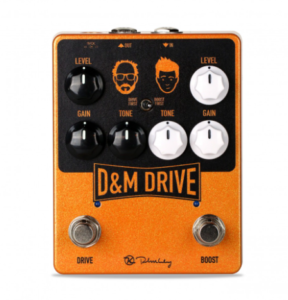
The Keeley Electronics signature pedal from That Pedal Show’s Mick Taylor and Daniel Steinhardt is a dual-format design featuring overdrive and boost sections.
They can be used individually or stacked. There are options to place the boost before or after the drive.
You can split the two circuits using TRS cables from the input and output jacks, so each can be used in a different loop of the switching system, essentially giving you two independent pedals.
Stacking the two sections together offers even more possibilities. Both routing options have their relative merits, but I really like how the boost before the drive increases the saturation allocation.
10. Nobels ODR-1
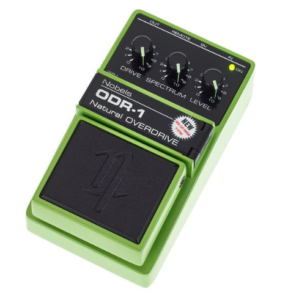
The Nobels ODR-1 dates back to 1985 and has graced the pedalboards of the likes of Guthrie Trapp, John Shanks, Micky Moody, and Tim Pierce.
If you’re looking for a great-sounding, natural analog overdrive, this overdrive pedal is one of the best options.
There are three rotary controls: Drive, Spectrum, and Level. The latest version of this pedal offers a Bass Cut switch to remove the lows (if needed). The circuit is a buffered bypass.
The battery compartment is included and unlike other pedals, the battery can be replaced very easily. This pedal can use 9-18V power.
If you want more headroom, use 18V. And guitar players will enjoy the glow-in-the-dark knobs.
11. Fender Santa Ana Overdrive
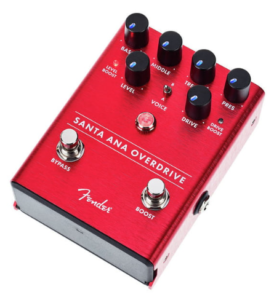
The Santa Ana produces fat lead tones and a unique hard rock rhythm crunch, and the switchable boost function is great for punching solos over the mix (level setting) or adding some super-creamy compression and sustain (gain setting).
In addition to the 3-band EQ, the Santa Ana overdrive includes a true bypass/buffer switch to select level or gain boost, a boost function switch, presence, and two different voice modes.
Other cool features include a magnetic battery access compartment on the front of the pedal and LEDs that illuminate the knob settings. Even cooler, you can control these lights by flicking a switch on the back panel.
12. Strymon Sunset Dual Overdrive
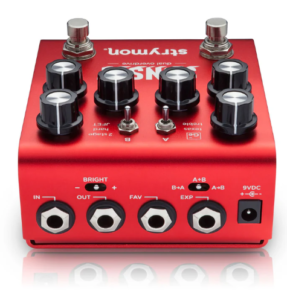
They say you get what you pay for, and Strymon pedals are right.
Anticipating every user’s needs, Sunset offers three distortion options with different topologies, as well as three boost options and flexible routing that lets you use a boost or drive first.
The second stage drive is the ‘Texas’, a particularly powerful and fun take on the company’s Tube Screamer.
When compared side by side with a real tube high gain amp, it’s hard to tell which is real and which is pedal.
13. Catalinbread Sabbra Cadabra
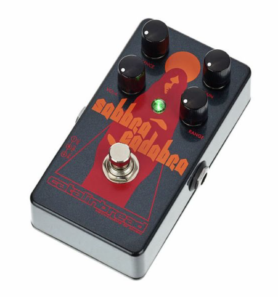
It’s hard to guess which specific genre of player the Catalinbread Sabbra Cadabra will appeal to. This gorgeous pedal is essentially a Rangemaster-based treble booster with a unique twist.
Volume, presence, and gain are all pretty standard, but the extra range control allows you to boost the high-end frequencies or the entire spectrum.
We found it worked best with a detuned guitar and a high-gain tube amp, and we had a world of fun unashamedly blasting out those iconic riffs full of that thick, loud tone we all know and love.
14. Strymon Sunset
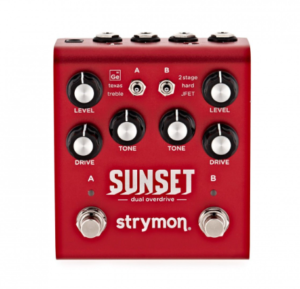
The Sunset is an odd one out on this list. It has an analog JFET gain stage, but the heavy lifting is actually done digitally, allowing for a much wider range of potential tones within the device.
There are two independent drives, each with its own controls that are easily accessible via the front panel.
On the left is a germanium diode-based drive, similar to some OCD models, with a Tube Screamer-style drive and treble boost, while on the right is a more complex two-stage drive.
These options alone offer a ton of versatility, but the real power of the Sunset is revealed when you consider that you can stack the sides to create even more complex drive tones.
From Queen-style treble boost to modern metal, this pedal can do it all without breaking a sweat.
The most satisfying thing about the Sunset is that, despite being a digital pedal, it can push the volume so high that it can saturate a tube amp just as much as an analog drive or boost.
What’s more, combining the Treble Boost with the JFET Analog Boost option allows you to create unique boost tones that complement the tone of a valve amp.
FAQs
What’s the difference between overdrive and distortion?
Overdrive and distortion are terms that are (often incorrectly) used interchangeably. Of course, they’re both basically versions of the same effect.
Distortion is the extreme big brother of overdrive, but they offer very different playing experiences depending on which one you choose.
The main difference is that a distortion pedal will provide the same or similar amount of distortion at all volumes, whereas an overdrive pedal will react more like an old-school tube amp.
The amount of gain and grit is determined by the amount of gain you choose, as well as the input and output volumes.
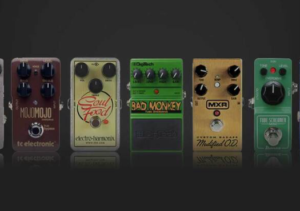
What do you want from an overdrive?
While overdrives don’t completely change the sound, many add tonal characteristics that players like, so you’ll want to consider your own unique sound.
Other overdrives really make your guitar and amp sound better, so if you’re happy with the tone as is but want a little something extra, you’ll want to look for a more transparent overdrive pedal.
Some overdrives offer more tone-shaping control than others. If you have a particular sound you like, look for one with more EQ controls. This will give you more ability to fine-tune your sound.
You can also use it to address problem frequencies within your amp.
For example, many metal players use a Tube Screamer or similar to push the front end of an already distorted amp a little further and tighten up the low end.
If you’re using an overdrive pedal for soloing, dialing in more high-mids and top end can help it pass through a live mix better.
Can I use multiple gain stages or overdrive pedals?
Some of the best overdrive pedals have different gain stages that can be foot-switched.
This can be very handy when playing live, as it can act like an extra channel on your amp.
Plug it into a clean amp, set one section of the pedal for a little crunch, and the other section for more gain, and you’ve got a three-channel amp that maintains your basic tone.
No matter which one you choose or how you use it, an overdrive pedal will give you a little more of what you already have, and give you a little more grit and volume to help you play with more feel and expression.
Stacking multiple overdrive pedals is also a very common practice, so if you have two pedals that you like the sound of or two pedals that sound great together, it’s worth experimenting with them and seeing what you get.
Conclusion
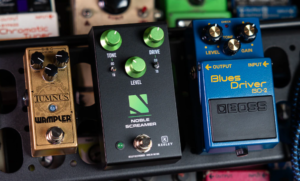
An overdrive pedal is a great addition to any pedalboard. And in many cases, they’re completely necessary.
However, the best overdrive pedal is subjective and will depend on your tonal needs, other gear, and signal chain. Some overdrive pedals sound best when used with other overdrives or fuzz or distortion pedals.
Some require a clean amp to sound good, while others are best used with an amp that has already had its gain cranked.
Your guitar amp can also have a significant effect. A good tube amp with a decent clean channel will be important. However, some overdrive pedals sound great when pushed with a distortion amp.
So my best recommendation is to start with the tone you want to reproduce. Then look at the features and build in the quality/quality of the components.
Also read: Top 12 Best High End DJ Mixers in 2025
